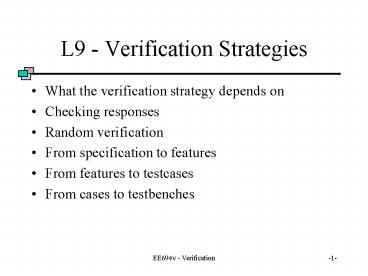L9 - Verification Strategies - PowerPoint PPT Presentation
1 / 18
Title:
L9 - Verification Strategies
Description:
... document to determine features that must be verified Each feature to be verified Feature of a UART Design Component-level Versus System -level Features ... – PowerPoint PPT presentation
Number of Views:60
Avg rating:3.0/5.0
Title: L9 - Verification Strategies
1
L9 - Verification Strategies
- What the verification strategy depends on
- Checking responses
- Random verification
- From specification to features
- From features to testcases
- From cases to testbenches
2
Strategy Depends On
- What needs verification
- Functionality of system/sub-system/part/
- Level of granularity
- Types of testcases and ability to verify
responses - Level of knowledge of implementation, i.e.,
white-box or black-box
3
Strategy Depends On (2)
- Level of abstraction
- High level - (courser granularity)
- Low level - (fine granularity)
4
Verifying the Response
- Verifying the response is a difficult task
- Applying stimulus is easy
- You must know
5
Methods to Check Response
- Visual inspection of the value of responses
- Visual inspection of the signal waveforms
6
Random Verification
- Does random verification mean you randomly apply
0s and 1s to inputs? - Can create conditions that are not covered in
verification plan
7
Random Verification (2)
- Must address how result will be checked
8
From Specification to Features
- Verification plan identifies the features that
will be verified - Use specification document to determine features
that must be verified - Each feature to be verified
9
Feature of a UART Design
10
Component-level VersusSystem-level Features
- Component can be a unit, reusable component or an
entire ASIC - System can be a subset of a few ASICs, an entire
board design, a few ASICs, a complete product, - System level features usually limited to
- - -
11
Error Types
- The type of errors depend on what the model
describes and how the design was captured
12
From Features to Testcases
- Features can be classified as must-have,
should-have, and nice-to-have - Must-have features
- Should-have features
13
From Features to Testcases (2)
- Should-have features (continued)
- Nice-to-have features
14
Testcase Grouping
- Features naturally fall into groups
- Example - A CPU interface
15
Testcase Grouping - (2)
- For each testcase, need expected response and how
the response will be determined valid/in error
16
Design For Verification
- Testing of some features is often very hard to do
- May require a change to design
17
From Testcases To Testbenches
- Testcases naturally fall into groups
- Each testbench should list the testcases it
implements
18
Verifying Testbenches
- Purpose of testbenches is to verify that design
meet the specification - Must ensure that testbench covers all must-have
features of the design completely - Testbenches should also cover the should-have
features adequately































